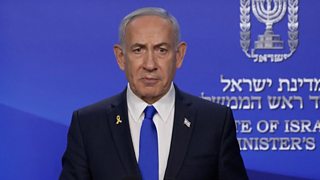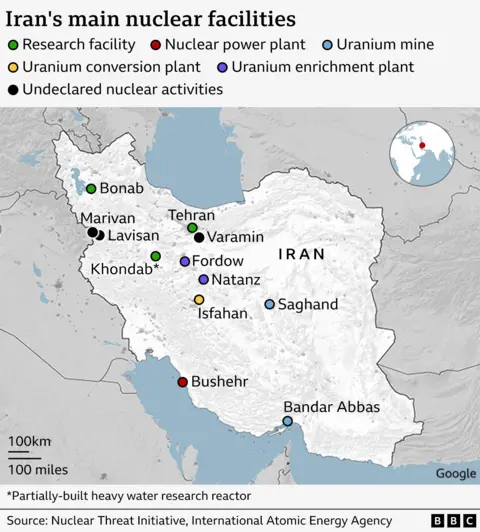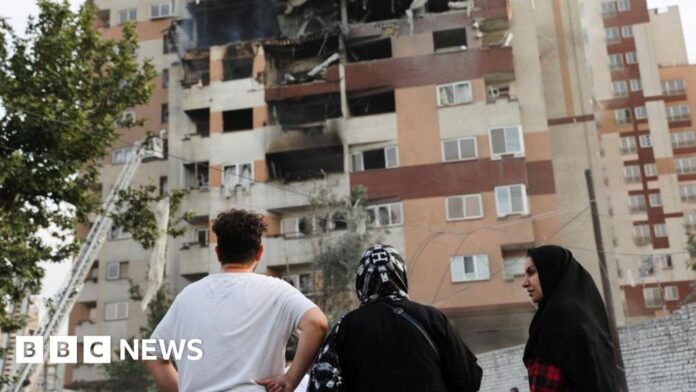Israel and Iran exchanged strikes overnight into Monday, as fighting between the two countries entered its fourth day.
The conflict began on Friday when Israel attacked nuclear and military sites in Iran. Iran retaliated with aerial attacks targeting Israel.
More than 220 people have been killed in Israeli strikes so far, according to Iran’s health ministry, while Israel says Iranian attacks have killed 24 people.
Here is what we know.
When and where did the strikes begin?
Explosions were reported in Iran’s capital Tehran at about 03:30 local time (01:00 BST) on Friday.
Iranian state television said residential areas in Tehran were hit, with blasts also heard north-east of the city.
Israel’s military said it had launched strikes on “dozens of military targets, including nuclear targets in different areas of Iran”.
In Israel, people were woken by air raid sirens and received emergency phone alerts, as a state of emergency was declared.
Hours after the initial strikes, Israel targeted the Natanz nuclear facility – about 225km (140 miles) south of Tehran. The Israel Defense Forces (IDF) said its attack caused significant damage.
Israeli Prime Minister Benjamin Netanyahu said the attack – called Operation Rising Lion – targeted “the heart” of Iran’s nuclear program. He claimed that “if not stopped, Iran could produce a nuclear weapon in a very short time”.
The global nuclear watchdog, the International Atomic Energy Agency (IAEA), has said it has not detected an increase in radiation levels at the plant.
Israel’s strikes killed Hossein Salami, commander of Iran’s Islamic Revolutionary Guard Corps (IRGC), and several senior military figures and nuclear scientists.
Iran said civilians, including children, were also among those killed.
BBC journalists are unable to report from inside Iran due to restrictions by the country’s government, making it difficult to assess the damage caused by Israel’s offensive.
The US has said it was not involved in the strikes, but President Donald Trump said he was aware of Israel’s plans beforehand.
How did Iran respond?
Iran’s Supreme Leader Ayatollah Ali Khamenei said Israel “should anticipate a severe punishment”, while its foreign minister called the strikes a “declaration of war”.
The foreign ministry said “the US government, as the primary patron of this regime, will also bear responsibility”.
Iran launched about 100 drones towards Israel on Friday morning, according to the IDF, adding that most had been intercepted.
Iran later launched a ballistic missile attack on “dozens of targets, military centres and airbases” in Israel, in an operation it called True Promise 3. The IDF said fewer than 100 missiles were launched towards Israel in two waves.
Bright flashes could be seen over Jerusalem and Tel Aviv, as Israel’s Iron Dome defence system attempted to intercept the attack.
The Israeli military told residents across the country to remain “close to protected spaces”, and to avoid gatherings and movement in public areas.
Strikes continue over the weekend
In Israel, sirens sounded in several areas, including Tel Aviv and Jerusalem, overnight into Saturday. Israel said its air force had hit dozens of targets in Tehran.
At least two people were killed in Rishon LeZion on the outskirts of Tel Aviv.
Oil infrastructure was hit on both sides, with a huge fire visible at Iran’s Shahran depot and flames breaking out near the Haifa oil refinery in Israel.
On Sunday, the third day of strikes, six people were killed in Israel’s Bat Yam when a 10-storey block of flats was hit. Four people were killed in Iranian attacks on the northern town of Tamra, emergency services and the local hospital said.
Israel’s military said on Sunday it had struck more than 80 targets in Tehran throughout the night, including the Iranian Ministry of Defense, and “additional targets where the Iranian regime hid the nuclear archive”.
Late on Sunday, sirens blared in Israel as incoming missiles were intercepted. Iranian state television said the country attacked Tel Aviv, Haifa and other cities with “tens of Iranian missiles and drones”.

How did we get to this point?
Netanyahu said on Friday that the strikes were “a targeted military operation to roll back the Iranian threat to Israel’s very survival”.
He said the operation would “continue for as many days as it takes to remove the spread”.
An Israeli military official told the BBC that Iran had enough nuclear material to create nuclear bombs “within days”. Iran has said that it has never sought to develop a nuclear weapon.
The strikes began as US talks over Iran’s nuclear programme, which started in April, appeared to have stalled.
The next round of talks, due to take place on 15 June, were cancelled. Iran had called them “unjustifiable” in light of Israel’s attacks.
Trump had hoped to strike a deal to stop Tehran developing a nuclear weapon. Iran has long insisted that its nuclear activities are peaceful.
Last year, Iran and Israel launched a number of air strikes against each other in April and October – though Israel’s strikes last year were not believed to have been as wide-ranging as its current operation.
Who was killed in Israel’s attacks?
The IDF said that three Iranian military commanders had been “eliminated in the Israeli strikes across Iran”.
They were:
- Hossein Salami, commander-in-chief of the Islamic Revolutionary Guards (IRGC)
- Gholamali Rashid, commander of Khatam-al Anbiya Central Headquarters
- Mohammad Bagheri, chief of staff of Iran’s armed forces
IRGC later said Amir Ali Hajizadeh, the commander of its air force, was also killed alongside a group of other IRGC forces.
The Israeli military said its overnight attack focused on “over 100 targets, including senior figures of the Iranian General Staff and leaders of the nuclear program”.
IRGC-affiliated news agency Tasnim reported six nuclear scientists were also killed in the strikes, of whom five have been named:
- Fereydoon Abbasi, former head Iran’s Atomic Energy Organization
- Mohammad Mahdi Tehranchi, who Israel accused of being involved in Iran’s nuclear weapons programme which Tehran denies exists
- Abdulhamid Minouchehr, head of nuclear engineering at Iran’s Shahid Beheshti University
- Ahmad Reza Zolfaghari, a nuclear engineering professor at Shahid Beheshti University
- Amirhossein Feqhi, another nuclear professor at Shahid Beheshti University
Ali Shamkhani, senior adviser to Iran’s Supreme Leader, was reported to have been seriously injured, according to Iranian media.
How have other countries reacted?
Reacting to the strikes, Trump said he gave Iran “chance after chance” to make a deal, but “they just couldn’t get it done”.
“Iran must make a deal, before there is nothing left, and save what was once known as the Iranian Empire. No more death, no more destruction, JUST DO IT, BEFORE IT IS TOO LATE,” he wrote on social media.
US Secretary of State Marco Rubio said the US was not involved with the strikes and did not provide any assistance. He said the top priority for the White House was to protect US forces in the region.
US citizens have been advised not to travel to Iran, with the state department on Friday urging those who are in the country to leave or “shelter in place”.
Russian President Vladimir Putin held separate phone calls on Friday with Netanyahu and Iranian President Masoud Pezeshkian, the Kremlin said. Russia is a key military and political ally of Iran.
Putin condemned the Israeli actions, and also “expressed the willingness to provide mediation services in order to prevent further escalation of tensions”, a statement said.
In other international reaction, Oman, which has been mediating US-Iran nuclear talks, said it held Israel responsible for “this escalation and its consequences”.
The UK, France, Australia and China were among the nations that expressed concern over the escalation and called for calm.
What is Iran’s nuclear programme?

Iran has long maintained that its nuclear programme is for peaceful, civilian purposes only. It has several facilities around Iran, at least some of which have been targeted in the Israeli strikes.
But many countries – as well as the global nuclear watchdog, IAEA – are not convinced the programme is for civilian purposes alone.
Last week, the watchdog’s board of governors formally declared Iran in breach of its non-proliferation obligations for the first time in 20 years.
It cited Iran’s “many failures” to provide full answers about undeclared nuclear material and Iran’s stockpile of enriched uranium.
An earlier IAEA report said Iran had enriched uranium to 60% purity, near weapons grade, to potentially make nine nuclear bombs.
ALSO READ:


